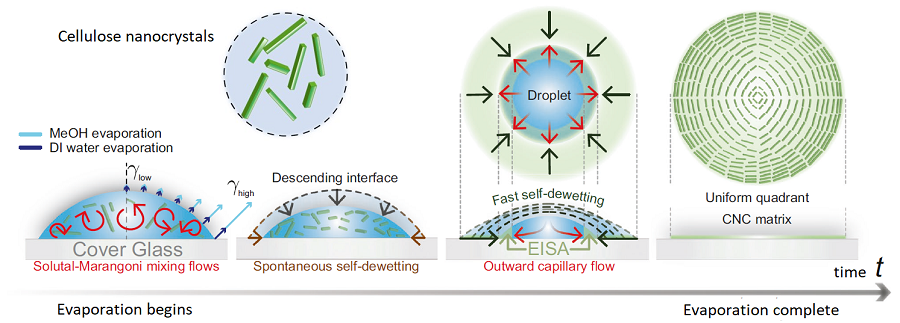A research team at KAIST has created a film coating technique that can be used to apply the photothermal effect of gold nanoparticles to industrial locations. This method eliminates the need for heating wires, anti-freeze chemicals to be sprayed or oiled on a regular basis, and changes to substrate design.
 Conceptual image to display Hydrodynamic mechanisms for the formation of a homogeneous quadrant cellulose nanocrystal (CNC) matrix. Image Credit: Korea Advanced Institute of Science and Technology
Conceptual image to display Hydrodynamic mechanisms for the formation of a homogeneous quadrant cellulose nanocrystal (CNC) matrix. Image Credit: Korea Advanced Institute of Science and Technology
Professor Hyoungsoo Kim of the Department of Mechanical Engineering (Fluid & Interface Laboratory) and Professor Dong Ki Yoon of the Department of Chemistry (Soft Material Assembly Group) announced on January 3rd, 2023, that they had created a novel technique that can evenly pattern gold nanorod (GNR) particles in quadrants through simple evaporation, and that they had used this to develop an anti-icing and de-icing surface.
Many scientists have attempted to manipulate substrate surfaces using various coating approaches in recent years, with those involving the patterning of functional nanomaterials receiving significant attention. GNR, in particular, is regarded as a viable candidate nanomaterial due to its biocompatibility, chemical stability, comparatively easy manufacturing, and stable and distinctive surface plasmon resonance feature.
To enhance GNR performance, it is critical to establish high uniformity during film deposition as well as a high level of rod alignment. However, meeting both requirements has proven to be a challenging task thus far.
To address this, the collaborative research team used cellulose nanocrystal (CNC), a next-generation functional nanomaterial derived easily from nature. By co-assembling GNR on CNC quadrant templates, the team was able to dry the film evenly and successfully generate a ring-shaped GNR film with uniform alignment.
The highly uniform and aligned GNR film developed through this research demonstrated enhanced plasmonic photothermal properties compared to existing coffee-ring films, and the team demonstrated that it could perform anti-icing and de-icing functions by merely irradiating light in the visible wavelength range.
This technique can be applied to plastic, as well as flexible surfaces. By using it on exterior materials and films, it can generate its own heat energy, which would greatly save energy through voluntary thermal energy harvesting across various applications including cars, aircrafts, and windows in residential or commercial spaces, where frosting becomes a serious issue in the winter.
Hyoungsoo Kim, Professor, Department of Mechanical Engineering, Korea Advanced Institute of Science and Technology
Professor Dong Ki Yoon added, “This research is significant in that we can now freely pattern the CNC-GNR composite, which was previously difficult to create into films, over a large area. We can utilize this as an anti-icing material, and if we were to take advantage of the plasmonic properties of gold, we can also use it like stained-glass to decorate glass surfaces.”
This research was carried out by Ph.D. student Jeongsu Pyeon from the Department of Mechanical Engineering, and his co-first author Dr. Soon Mo Park (a KAIST graduate, at present a post-doctoral associate at Cornell University), and was published in the online volume of Nature Communication on December 8th, 2023.
The research was acknowledged for its accomplishments and chosen as an editor's highlight for the journals Inorganic and Physical Chemistry, Materials Science and Chemistry, and Materials Science and Chemistry.
The team received sponsorship from the Individual Basic Mid-Sized Research Fund from the National Research Foundation of Korea and the Center for Multiscale Chiral Architectures.
Journal Reference:
Pyeon, J., et. al. (2023) Plasmonic metasurfaces of cellulose nanocrystal matrices with quadrants of aligned gold nanorods for photothermal anti-icing. Nature Communication. doi:10.1038/s41467-023-43511-9.